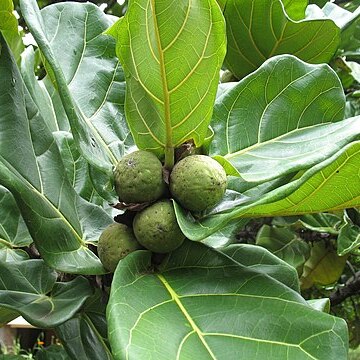A small tree. It grows 5-6 m high. It can be 13 m high. It has a rounded crown. The bark is dark grey and rough. The leaves are scattered or clustered at the tips of branches. They are oval and 11 cm long by 11 cm wide. They are thickly leathery. The upper surface is dark green and shiny. The lower surface has rust coloured woolly hairs. The male and female flowers are greenish-yellow. The fruit is round and rusty-yellow. They are 3-4 cm across. They are fleshy with a rather hard skin. The flesh is edible.
Female flower: calyx 3 mm in diameter, shallowly cupular, 5–8-lobed, the lobes 0.5 mm long, broadly triangular; ovary 3–4 × 3–4 mm, subglobose, 4-locular, densely ferrugineous-tomentose; styles 4, 3 mm long, multifid-flabelliform, the segments oblong, rounded, flattened, shallowly rugulose, abaxially puberulous, stigmatic surface glabrous.
A much-branched evergreen tree up to 12 m high, with a wide spreading rounded crown and a short clear bole (usually up to c. 1–2 m) up to c. 30 cm d.b.h.; bark striated to longitudinally fissured and finely transversely cracked or reticulate, corky, brittle, dark grey or blackish, occasionally exuding a viscous transparent fluid.
Fruits 4 × 4 cm (fresh), 3 × 3 cm (dried), subglobose to imperceptibly 4-lobed, smooth, reddish-brown or greenish at first, later becoming orange-yellow. Pyrenes 4, 2 × 1.1–1.2 × 0.8 cm, strongly carinate, bisulcate, apiculate, tricuspidate-emarginate at the base, lateral lobes smooth, entire.
Male peduncles 0.7–2 cm long, sometimes 1–2-bracteolate; inflorescence bracts (5)7–11, 5–7 × 3–5 mm, broadly elliptic or elliptic-obovate, the outer pubescent without, the inner mostly glabrous, pale yellow or whitish; head (5)7–8 mm in diameter.
Female peduncles 4–5 mm long, extending to c. 1 cm and thickening in fruit, 2-bracteolate, minutely lepidote, the bracteoles ferrugineous crisped-puberulous; bracts more or less as in the male.
Male flowers: calyx lobes 4–5, 1 mm long, acute or bifid, glabrous; stamens 4, filaments 1 mm long, flattened, anthers 1 × 1 mm, yellow; pistillode 1.5 mm high, infundibuliform, pubescent.
Young twigs 0.4–1 cm in diameter, fairly stout, evenly to densely crisped-puberulous or crisped-pubescent.
Leaves subsessile to shortly-petiolate, petioles 0.5–2(4.5) cm long, stout.
Seeds 1.5 × 0.8 × 0.5 cm, resembling the pyrenes in shape, brown.
Inflorescences usually borne for 15–30 cm below the leaves.
Stipules 5 mm long, filiform, pubescent, soon falling.
Wood somewhat pulpy, reddish.


